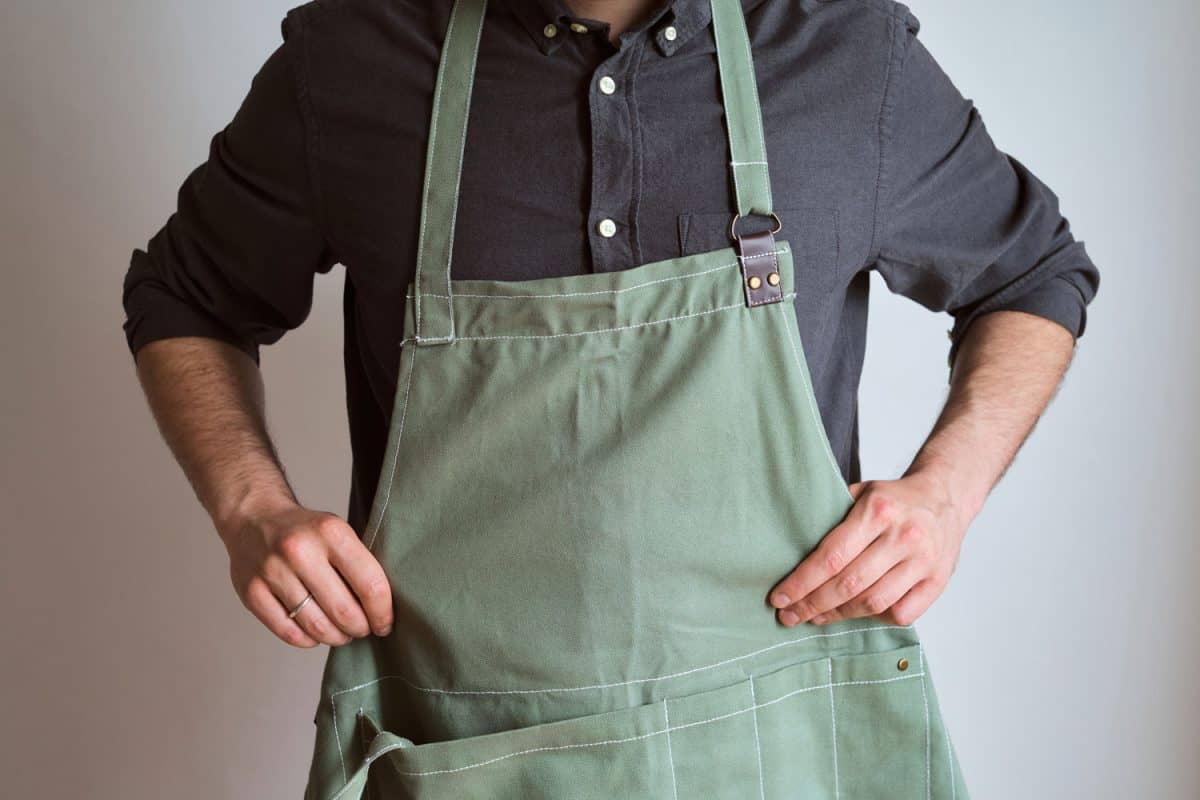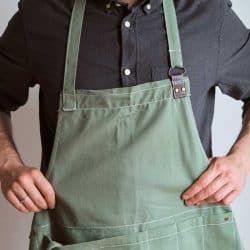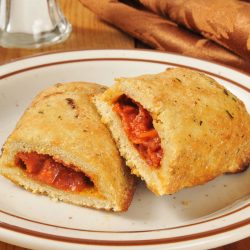The thought of wearing an apron probably brings to mind images of grannies in ruffled dimity print or someone at the grill sporting a body-length "Kiss the Cook" smock to protect their clothes from grease. Aprons are made in a lot of different forms but are to protects one's clothes when cooking. You are probably wondering if the apron you wear should be lined. We have researched all about this for you. Here you will find out everything you need to know about aprons.
You do not necessarily have to line an apron. This answer mainly depends on the type of material your apron is made out of. People wear aprons for a variety of functions. They can be incorporated into numerous jobs. With that said, it is a good idea to wear a lined apron when cooking foods at a high temperature, such as with grease when frying or working with hazardous materials.
Keep reading to learn more about what to line an apron with, what type of fabric is best for aprons, including chef, server, and dishwashing aprons, as well as the difference between a smock and an apron. We will explain the purpose of pockets in an apron, what half aprons are for, and which aprons the folks at Bon Appetit wear.
![Portrait of a handsome young man standing at his food stall with a box of ingredients, Should An Apron Be Lined? [What You Need To Know]](https://kitchenseer.com/wp-content/uploads/2021/06/Should-An-Apron-Be-Lined-What-You-Need-To-Know.png)
Contents
What You Should Know About Aprons
There are many reasons to wear an apron. For example, painters wear an apron to protect their clothes from paint. Butchers wear an apron to keep blood off of their clothes. Aprons are typically used to protect your clothes from spills, splatters, and stains. You can also wipe your hands on your apron since they are often made of washable materials.
Because the clothes we wear throughout the day get germs on them, aprons protect our food from those germs. Aprons can also protect your clothes and skin from dangerous materials and hot liquids or foods.
The most common aprons are made from the following materials:
- Cotton or muslin
- Rubber or nylon
- Leather
- Canvas
- Vinyl
- Denim
- Other materials
What do you line an apron with?
What you line an apron with really depends on what purpose you are using the apron for. Consider if your primary purpose is to cook, clean, or work with potentially hazardous materials.
The most common aprons are made of cotton or muslin. Muslin is made from cotton but has a more open weave causing it to be looser. This type of apron is used for baking, serving, working with dry ingredients or materials; the less messy jobs.
Cotton Aprons
Cotton is absorbent; therefore, it is not resistant to water. You can line cotton aprons with muslin to make them thicker, heavier, and more of a protective barrier. Waxed cotton is another option with the added benefit that it repels moisture.
Rubber or Nylon Apron
Rubber or nylon aprons are heavier and better for situations where you may get wet. This is especially important regarding dangerous substances that might damage your clothes or your skin. These are considered to be industrial aprons. You do not need to line rubber aprons.
Plastic Aprons
Plastic aprons need to be thrown away, while rubber-coated cotton is almost as good as using rubber. Rubber-coated aprons are more comfortable than plastic aprons. The rubber-coated cotton can be used as a lining material.
How to Line an Apron

Cut Your Lining
First, you want to cut your choice of material out to be the same size as your current apron. Watch out for the strings so that you do not accidentally cut those off. You can do this by folding your apron in half top to bottom and then placing it on your lining material, also folded in half top to bottom. Using a straight-edge and rotary cutter makes this process easier and more accurate, but you can do this with scissors as well.
Sew the Sides
After cutting your lining material, open it up and unfold your apron as well. Lay your lining material print side down and sew the top three sides. This includes around what will be the armpit area.
Trim
When you are finished sewing all sides except for the bottom, trim the corners as close to the threading as possible without cutting into the thread that holds the two pieces together. After you trim the corners, turn your apron right side out.
Iron
Once your apron is right side out, use a needle, dowel, or even a butter knife to push the corners out from the inside. Next, iron your apron. Pull the lining fabric back approximately one inch, iron under it. Turn in the original fabric to match the one-inch fold of the lining fabric. Then, put the new material down and iron over it. This creates a hem.
Hem
After the hem is created, sew across the bottom. Finalize your project by using a 1/2 inch or larger double-fold seam to create the ties. You will need two lengths of this 1/2 inch or larger material so that you have one for each side. Make them as long as you or the person you are making this for will need to tie it around their body.
Sew the two lengths of fabric you chose for your ties around the middle and armpit areas of your apron. Attach the other ends of the lengths of fabric around the middle of your apron in the front for your waist, and you are ready to go!
What type of fabric is best for aprons?
Chef Aprons
Chef aprons are most commonly made with 100% cotton or a blend of polyester and cotton. They are usually woven since they are needed to protect the person wearing them from thermal hazards. Wax cotton is preferable since it repels moisture.
Server Aprons
For server aprons, the best type of fabric is also cotton, muslin, or a mixture of polyester and cotton. This is because the purpose of server aprons is similar to that of chef aprons.
Dishwashing Aprons
The best type of fabric for dishwashing aprons is rubber. This is because rubber is resistant to water.
Industrial aprons
Industrial aprons are made from heavy-duty materials such as vinyl, canvas, or leather. This is because these materials are durable. In construction or a craftmanship job, leather is probably your best choice. Leather is tough, long-lasting, and can be purchased for a reasonable price.
Welding Apron
Another example of a job you would want to wear a leather apron for is welding. Whatever job you can think of where you would need to be protected from fire, sparks, or other potentially hazardous elements, a leather apron is best.
Medical Apron
In the medical industry, there are specific aprons made to protect your body. This particular kind is to protect you from the radiation that x-rays emit. They are called lead aprons even though they are lead-free. These are made with heavy metals. They remain lightweight and non-toxic.
What is the difference between a smock and an apron?
There are a few differences between a smock and an apron. Generally, a smock goes over your head. It covers the majority of your body. It is more like a loose-fitting dress. Most smocks cover your arms as well as the front of your body. They also tend to have pockets, whereas some aprons do not.
An apron mainly only covers the front of your body. Aprons usually have a strap that you either put your head over, and it hangs on your neck or has two straps that you tie around your neck. Aprons also have a tie for around your waist.
What are the pockets on aprons for?
The pockets on aprons are made for a plethora of reasons. The pockets on an apron can be used for whatever you need them for. Good examples of things you may want to store in the pockets on your apron are a sponge or washcloth for cleaning or an oven mitt for when you need to remove hot pans from your oven.
If you are a florist, you might wear an apron to hold your tools and twine. If you are a gardener, you may want to utilize the pockets on your apron for your trowel and seeds. A server may use their pockets for a notepad, pen, straws, and tips. A carpenter might use their pockets for nails, screws, or lightweight tools.
What are half aprons for?
Half aprons are also known as waist aprons, while the more common type of apron is a bib apron. The purpose of a half apron is mostly to utilize the pockets and protect your legs and lap from spills, stains, dust, and dirt. These are most commonly worn amongst servers and people who work in construction or carpentry.
What aprons do Bon Appetit use?
The aprons Bon Appetit uses are cross-back aprons that do not require tying. The other kind they wear is by Hedley & Bennet.
Click here to see this Amytalk Cross Back apron on Amazon.
See another Cross Back apron option on Amazon here.
Click here to see the Hedley and Bennet Abalone 3.0 Apron on Amazon.
In Closing
Aprons serve many purposes. Whatever job you may be facing, wearing an apron will probably benefit you in one way or another. They do not have to be lined but can be. The most commonly lined apron is made of cotton and is layered for reinforcement.
Check out the following links to learn more about aprons:
13 Novelty Aprons For Men [Gift Ideas]








![Unknown man wearing fancy apron with arms crossed, 13 Novelty Aprons For Men [Gift Ideas]](https://kitchenseer.com/wp-content/uploads/2020/05/Unknown-man-wearing-fancy-apron-with-arms-crossed-250x250.jpg)
